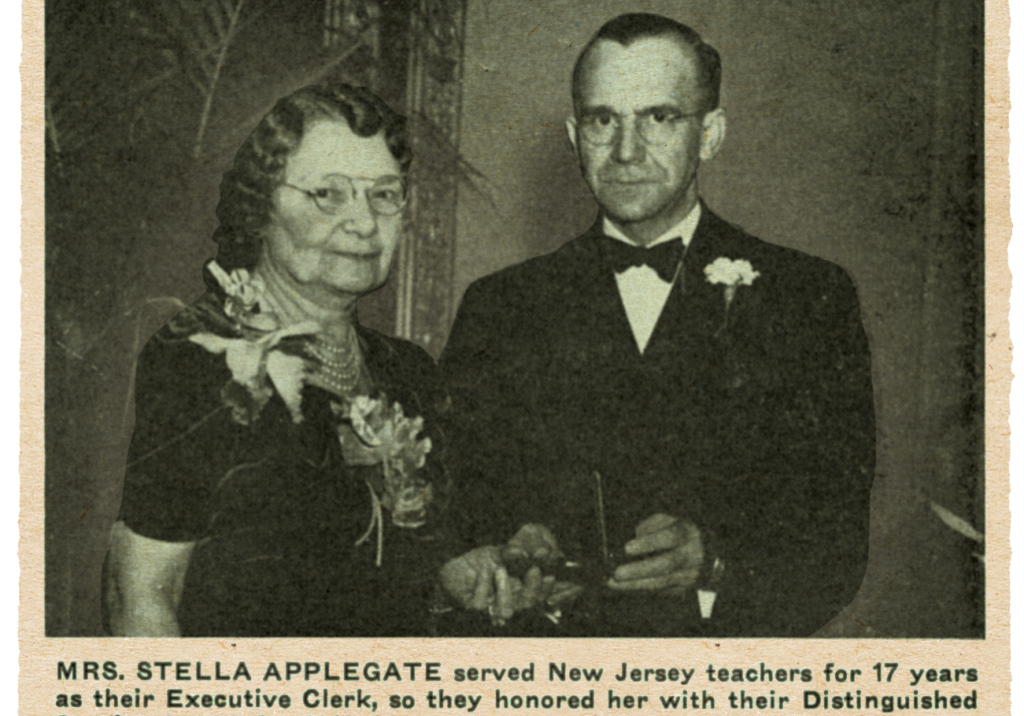Stella Applegate worked for NJSTA/NJEA from 1923 to 1940
From its founding on Dec. 28, 1853, until 1923, NJEA, then known as the New Jersey State Teachers Association (NJSTA), was run entirely by members who volunteered their time to serve their colleagues. Those volunteers, including NJSTA’s first female president, Elizabeth A. Allen, had recently achieved a series of successes, most notably the creation of a pension system for public school teachers and the passage of the tenure act.
On the other side of the ledger and in the wake of World War I, inflation had greatly reduced teachers’ purchasing power and there was an acute shortage of qualified teachers. Hiring a full-time staff person was proposed to the NJSTA Executive Committee as one way to strengthen the association and to improve the lot of educators and public education.
An office in Trenton
Other states were doing the same thing. In 1921, the Pennsylvania State Teachers Association, now PSEA, was the 14th state association to create the position of executive secretary. To create a similar position in New Jersey, dues were raised from $0.50 to $1, and the question of a full-time secretary was referred to the Executive Committee, which subsequently reported in favor of it, but said it could not be done short of $2 dues. It proposed, instead, that the association set up “an office of administration in Trenton.”
“The purpose of an administrative office is to put the work of the association on a business basis,” reads the report from the NJSTA Executive Committee at the time. “The plan would require the employment of one clerk who would perform much of the detail work now done by the [elected/volunteer] secretary. She would gather information for Standing and Special Committees. She would keep the files and records; issue bulletins of interest to the teachers; keep the local associations in touch with the State Association, etc.”
“A very competent person”
The report noted that the plan of having a clerk work under the direction of the Executive Committee would give the NJSTA all the benefits of a well-knit, unified organization, and, at the same time, avoid what it referred to as the “commonly objectionable features involved in the plan of having a full-time secretary.”
In April 1923, NJSTA opened an office in Room 304 of the Stacy Trent Hotel, with “a very competent person placed in charge.”
That “very competent person” was Stella S. Applegate who was to remain a fixture in association affairs until she retired in 1940. In addition to many other aspects of her work, Applegate managed the New Jersey Educational Review (now the NJEA Review) for the first seven years of its existence.
Upon her retirement, NJEA gave Applegate the Award for Distinguished Service to Education. That award continues to be conferred at the annual NJEA Convention.
180 West State Street
NJSTA, which became NJEA in 1938, remained in the Stacy Trent Hotel until it moved to its own headquarters building—the Roebling Mansion at 180 W. State Street in 1951. The property is the location of the current headquarters. The Roebling Mansion was torn down in 1962 and replaced with a new headquarters building in 1963. In 2001 that building was demolished, and the current one was built.
Starting with one full-time staff member in 1923, today NJEA has 245 full-time staff members and 150 part-time consultants. You’ll find them listed in this edition of the NJEA Review on pages 40-43.
In addition, the voluntary work of members remains essential to the association’s power and success. Those who volunteer their time to serve on NJEA’s many committees are listed on pages 32-39.
